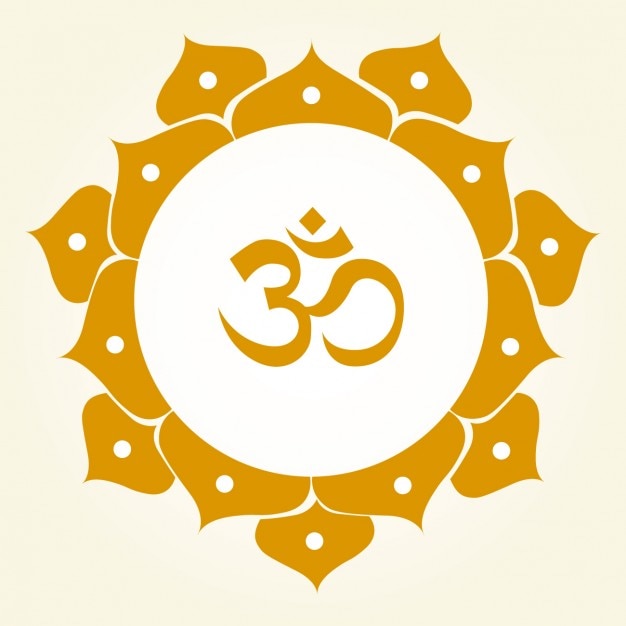For lots of us, the sound Om probably conjures up lots of images like this:

Which is not necessarily the most relatable visual for many of us who are squeezing ourselves into a 6pm Flow class after a long day at work. But Om is, by its very definition, for everyone. So let’s dig a little deeper, past the clichés and the stereotypes, and find out what it is about this sound that makes it so magical.
If you’ve ever attended a yoga class with a more traditional teacher, the class might have started with everyone coming together in a chant or three: the chant of Om.
I LOVE this chant now, and although I can’t remember the first time it happened in a class, I can imagine I was probably a bit thrown.
Because it’s kind of weird, right?
A room full of people just chanting this word we don’t even know the meaning of? A word in a whole other language? Out loud? In front of OTHER HUMAN BEINGS?
Yeah, no thanks. It’s okay if you feel that way. I’m sure I did at one point too. But I really do feel that incorporating chanting into our yoga practice has a whole heap of benefits, and Om is by far the most common.
I’m going to go through the meaning of Om in just a moment. But here’s the thing. The meaning doesn’t really matter. It only matters that you do it. To be honest, that kind of is the meaning. Because sound vibrations affect us more than we know.

The meaning.
It’s believed that the first appearance of Om came in the Upanishads. (The Upanishads are a collection of ancient Sanskrit philosophical texts that contain some of the central philosophical ideas of Hinduism. But that’s a – very long – story for another blog post.) In fact, the Mandukya Upanishad is totally devoted to Om, stating that: “Om is the imperishable word. Om is the universe, and this is the exposition of Om. The past, the present, and the future, all that was, all that is, all that will be is Om. Likewise, all else that may exist beyond the bounds of time, that too is Om.”
So, uh, basically it’s just the sound of the whole entire universe. No big deal, or anything.
How to chant it.
First of all, what we’re chanting is not actually Om.
WHAT?
I know, minds blown right?
It’s techinally pronounced Aum.
And Aum isn’t even one sound – it’s actually four syllables, made up of each letter – A, U, and M – and the silent syllable, or Anagata (Wild, right? As an English teacher by day, the discovery of a SILENT SYLLABLE was super exciting to me. It’s fine if you’re cooler than me and not too concerned by this).
A is pronounced as a long ‘ahhh’ or ‘awww’. Imagine the cutest animal picture in the world, and the sound you make is what you need here. You know what, I’ll help you out a bit with that one.
Start at the back of your throat and then lengthen, feeling your chest and third chakra (solar plexus) begin to vibrate.
U is pronounced ‘oo’, at which point you’ll feel your throat begin to vibrate. Think like your best friend just told you something supremely scandalous. OOOOH.
And, finally, we have our third syllable ‘M’, pronounced like a long ‘mmmmm’ (think about your mum’s home cooking here), bringing those good vibrations to the top of your mouth.
It’s all about those good vibrations.
And that mysterious last syllable? It’s the silence of the Infinite. Sit in silence. Silence is okay. More than okay, silence is good, and as a society we seem to be way too afraid of it. Let your ‘m’ trickle off into deep silence as you connect with yogis the world over doing the very same thing.
So that’s how we chant it. Now how about why we chant it?
Okay. Let’s get science-y.
The chant Aum vibrates at the frequency of 432 Hz, the same vibrational frequency found throughout everything in nature. What better way to connect? Not only to ourselves and other yogis, but all other living beings and the world around us.
Okay. Let’s get physical. (physical.)

When we chant Aum, the vibrations help to slow down the nervous system and calm our stressed out monkey minds. This has numerous health benefits, both physically and mentally, from soothing our adrenal glands to helping to relieve anxiety and stress.
Okay. Now let’s get practical.
Om makes our practice time sacred. It signals a beginning to an experience in which we are caring for ourselves, which in turn will trickle to enabling us to care for others in our time off the mat. It helps to separate our yoga practice from the day that we have just come from, from the to-do list that lies ahead. And when you hear a room full of people come together chanting what is energetically and vibrationally the sound of the universe, it’s pretty magical.
And much like utilising Gyan Mudra in our practice, chanting Om connects us to those who have practiced before us. Yoganand Michael Carroll, Dean of the Kripalu School of Yoga, says that: “It’s a sound that validates oneness and harmony. We chant it because yogis have for thousands of years. And when we chant it, we’re connecting with those yogis in a ritual way, and drawing upon the support of the practices they’ve been doing for a long, long time.
So. Are you into it?
In my humble opinion, I think that chanting Om or Aum is such a beautiful way to connect with the other people in our classes. Hearing the difference between how it sounds at the beginning of class (often scratchy, nervous, and tentative) and at the end of class (often triumphant, clear, and strong). Feeling that grounding and connection to the people and world around us is something truly special, as well as signalling to my mind that this time on my mat is sacred and should be treated as such.
I’m curious to hear what you guys think – would it put you off a particular class if Om chants were included in class? Or would it add to your experience?

I hope this has been helpful! I know I learned a whole lot while researching, and it’s made me even more interested in mantra and vibrations and the universe and all of that good stuff. I’m excited to learn more and share it all with you as I do!
Om, shanti. (Or – peace for the all human kind, peace for all living and non-living beings, peace for the universe, peace for each and every thing in this whole cosmic manifestation. But the Sanskrit is a lot snappier.)
Sarah.



